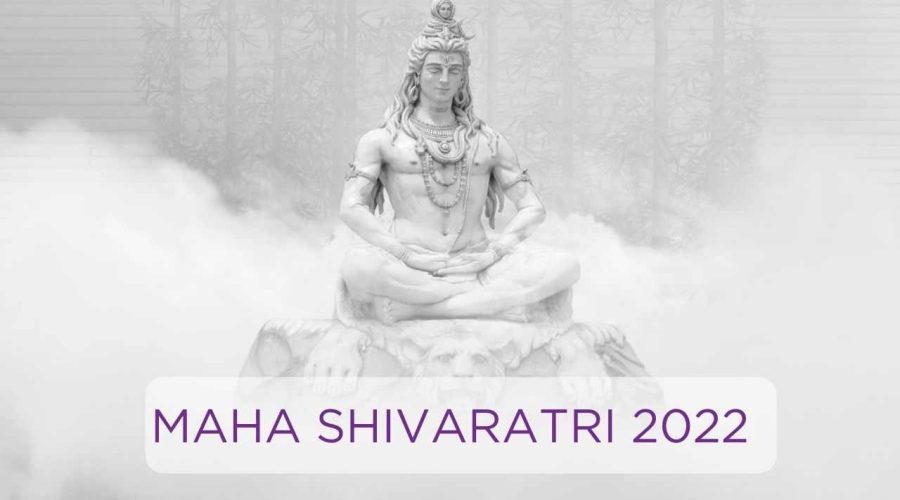Maha Shivaratri 2022: Know the Date, Time, Significance of this Auspicious Day
Lord Shiva, the Hindu god of destruction and regeneration, is honored every year during Maha Shivaratri, a well-known Hindu festival.
Shiva is claimed to have completed the Tandava Nritya, or primordial creation, preservation, and destruction, on Maha Shivaratri night. Believers claim that this rescued the world from destruction. Maha Shivaratri is said to be the day when Shiva drank deadly negativity to safeguard the world, according to Hindu academics.
It is a national holiday in most states of India, as well as a public holiday in Mauritius and Nepal.
Maha Shivaratri Date 2022
Maha Shivaratri on Tuesday, March 1, 2022
Nishita Kaal Puja Time – 12:08 AM to 12:58 AM, Mar 02
Duration – 00 Hours 50 Mins
On 2nd Mar, Shivaratri Parana Time – 06:45 AM, Mar 02
Ratri First Prahar Puja Time – 06:21 PM to 09:27 PM
Ratri Second Prahar Puja Time – 09:27 PM to 12:33 AM, Mar 02
Ratri Third Prahar Puja Time – 12:33 AM to 03:39 AM, Mar 02
Ratri Fourth Prahar Puja Time – 03:39 AM to 06:45 AM, Mar 02
Chaturdashi Tithi Begins – 03:16 AM on Mar 01, 2022
Chaturdashi Tithi Ends – 01:00 AM on Mar 02, 2022
Every lunar month, on the 13th night and 14th day, Shivaratri is observed. The Shivaratri in the month of Falgun (Phalguna), the Hindu calendar’s last month, is known as Maha Shivaratri, which means “the Great Night of Shiva.” It occurs just before Spring arrives, usually in February or March according to the Western calendar.
Goddess Parvati and Lord Shiva remarried on Shivaratri.
Shivaratri Celebration
Offerings of Bael (Bel Tree) leaves to Lord Shiva, all-day fasting, and an all-night vigil are the main features of the celebration. “Om Namah Shivaya,” Shiva’s sacred mantra, is recited throughout the day in Shiva temples on Maha Shivratri. At homes and temples, special Pujas are performed.
The Bel tree, also known as the bilwa or bilva tree, is said to be a favourite of Lord Shiva, and its leaves and fruit are still used in his devotion.
Huge celebrations are held in temples around India, the largest of which is held in Ujjain, Madhya Pradesh, where Lord Shiva is claimed to have stayed. Shiva shrines in Tamil Nadu, Andhra Pradesh, and Uttar Pradesh hold special celebrations.
In Hindu society, all castes (divisions) participate in Shiva worship. Hindu women, particularly those who aspire to become pregnant, are drawn to the rites surrounding Shivratri.
Significance of Maha Shivratri
Maha Shivratri is considered the most auspicious of the 12 Shivratris held each year. Shivratri is said to be the night when Shiva and Shakti, the masculine and feminine energies that keep the planet in balance, come together. This is a serious celebration in Hindu culture that commemorates ‘overcoming darkness and ignorance in life.’
Throughout history, various tales have described the significance of Maha Shivratri, with one of them claiming that Lord Shiva performs his cosmic dance of ‘creation, preservation, and destruction’ on this night. Another tradition claims that on this night, offering Lord Shiva’s images can help a person overcome and let go of their sins, letting them to reach Mount Kailash and attain’moksha.’
Frequently Asked Questions
1. Why is Maha Shivratri celebrated?
Maha Shivratri is primarily a Hindu festival commemorating Lord Shiva, the God of Destruction, and is observed yearly. According to the Hindu calendar, Shivratri is observed in every month of the luni-solar calendar, but once a year, in late winter, Maha Shivratri is observed to honour the approaching summer.
2.What is difference between Shivratri and Maha Shivratri?
Shivratri takes place every month, however Maha Shivratri is Shiva’s magnificent night, which comes only once a year. Shivratri is celebrated on the 14th day of each lunar month. In a calendar year, there are twelve Shivratris that occur a day before the new moon.
3. How long does Maha Shivaratri last?
According to the Hindu lunisolar calendar, Maha Shivaratri is observed for three or 10 days.
4. Which Colour should wear on Shivratri?
Devotees take an early bath, dress in auspicious green clothing, and visit the nearest Shiv temple to offer prayers to the Shiva Linga on this day. If you can’t wear green on this day, you can wear red, white, yellow, or orange instead.

